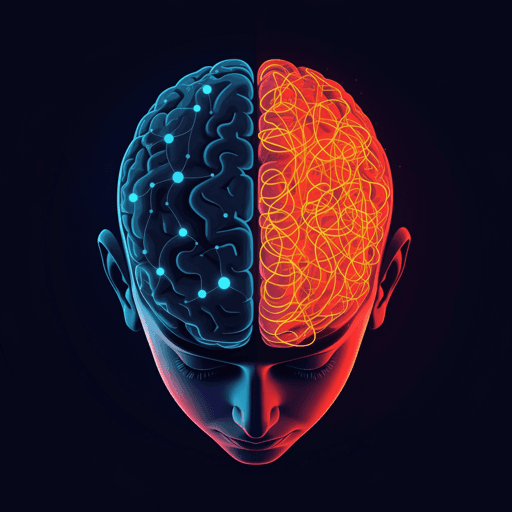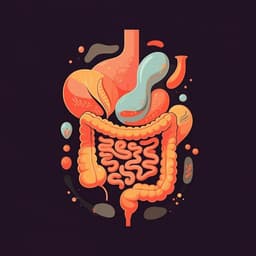
Medicine and Health
Diagnosis of adolescent depression with sleep disorder based on network topological attributes and functional connectivity
S. Hu, X. Zuo, et al.
Using resting-state fMRI and brain network metrics, this study predicts sleep disorders in depressed adolescents by combining betweenness centrality and functional connectivity — finding altered BC in MTG.R, DCG.L and CAU.L and pronounced MOG.L–MTG.R connectivity changes. An SVM achieved 81.40% LOOCV and 74.19% external accuracy. Research conducted by Authors present in <Authors> tag.
~3 min • Beginner • English
Introduction
Adolescence is a period of heightened vulnerability to depression and sleep disorders. Sleep disturbances are prevalent in adolescent depression and are associated with more severe symptoms and suicide risk. Diagnosis of sleep disorders often relies on subjective reports that can diverge from objective measures, highlighting the need for scalable biomarkers. Resting-state fMRI enables investigation of brain functional networks. Traditional pairwise FC analyses may miss global network properties; graph-theoretical metrics like betweenness centrality (BC) identify hubs mediating information flow. Prior work shows FC alterations in depression and sleep disorder populations (e.g., DMN dysregulation) and suggests FC among temporal cortex and limbic regions mediates links between depressive symptoms and sleep quality. Machine learning, particularly SVM, has shown promise in psychiatric classification, but few studies integrate both FC and topological attributes. This study tests whether adolescents with depression and sleep disorders exhibit distinct BC and FC patterns versus those without sleep disorders, and whether an SVM model combining BC and FC improves classification performance. Hypotheses: (1) significant group differences in BC and FC exist; (2) combined BC+FC features outperform single-feature models; (3) discriminative SVM features overlap with group differences and can serve as neuroimaging biomarkers.
Literature Review
Resting-state network analyses in depression reveal increased and decreased FC within the DMN, enhanced DMN–frontoparietal coupling, and aberrant attention network FC, linked to self-referential processing and executive control abnormalities. Sleep disorders are closely associated with DMN dysfunction. In mixed cohorts, FC among hippocampus, amygdala, temporal cortex, and precuneus mediates the association between depressive symptoms and sleep quality. Graph theory advances reveal the brain’s small-world network topology; BC identifies hub nodes critical for information flow and shows stability in adolescents. Limited sleep research implicates frontostriatal topology (e.g., putamen BC correlating with sleep disturbance). ML studies using FC or structural features have classified psychiatric and sleep disorder phenotypes, but multi-feature fusion (FC plus topological attributes) has shown superior performance in schizophrenia classification, suggesting enhanced diagnostic utility for psychiatric disorders.
Methodology
Design and participants: Cross-sectional rs-fMRI study of 117 adolescents (12–18 years, right-handed) meeting ICD-10 criteria for depressive episode or recurrent depressive disorder, confirmed by two psychiatrists. Exclusions: substance abuse, other psychiatric disorders, traumatic brain injury or major medical illness, metal implants, or refusal of MRI. Discovery dataset: n=86 (June 2022–June 2024). Independent validation dataset: n=31 (June–October 2024). Ethics approved; written informed consent obtained. Measures: Depression severity with 24-item Hamilton Depression Rating Scale (HAMD). Sleep quality with Chinese Pittsburgh Sleep Quality Index (PSQI); PSQI ≥ 11 classified as sleep disorder. Grouping in discovery dataset: 44 with sleep disorder; 42 without. MRI acquisition: 3.0T GE MR750w. Structural T1 BRAVO: TR=8.5 ms; TE=3.2 ms; TI=450 ms; FA=12°; FOV=256×256 mm; matrix=256×256; slice thickness=1 mm; 188 sagittal slices; 296 s. Resting-state BOLD GRE-SS-EPI: TR=2000 ms; TE=3.2 ms; FA=90°; FOV=220×220 mm; matrix=64×64; slice thickness=3 mm; gap=1 mm; 35 axial slices; 185 volumes; 370 s. Quality control included exclusion for motion >3 mm/3° and low image quality. Preprocessing: SPM12 and DPABI. Discard first 10 volumes; slice timing correction; realignment; motion parameters estimated (<3 mm/3°). Frame-wise displacement (FD) computed; volumes with FD>0.5 mm regressed. Nuisance regression: linear drift, Friston-24 motion, global, white matter, CSF signals. Coregister structural to mean functional; DARTEL normalization to MNI; resample to 3-mm isotropic voxels; bandpass 0.01–0.1 Hz; linear detrending. FC analysis: AAL-90 atlas ROIs; Pearson correlations between ROI time series; 90×89 connectivity matrix per participant; Fisher’s Z-transform applied. Network topology (BC): GRETNA toolbox. Correlation matrices binarized via sparsity threshold S, ensuring small-worldness (σ>1.1). S varied 6–34% in 1% steps; compute nodal BC at each S; integrate BC across S to obtain AUC per node used for analysis. Statistical analysis: Demographics via chi-square (gender) and t-tests (age, education, disease duration, HAMD, PSQI, head motion) with p<0.05. Group differences in BC and FC via two-sample t-tests in GRETNA; covariates included sex, age, disease duration, head motion, HAMD after collinearity testing; Bonferroni correction applied (p<0.05). Pearson correlations between altered BC/FC and PSQI; Bonferroni correction for 12 tests set α=0.0042. Machine learning: SVM (LIBSVM, MATLAB R2022b) with linear kernel. Features: whole-brain FC and BC values (not limited to significant group-difference features). LOOCV on discovery dataset (86 folds): at each fold, normalize training data and apply same parameters to test; feature selection on training data using F-score metric; select top 100 features per fold; grid search for optimal C (linear SVM). Evaluate per-fold test accuracy; compute mean accuracy across folds; ROC and AUC computed; significance assessed via 1000-label permutation LOOCV procedures forming null distribution. Consensus features: features selected in all 86 LOOCV iterations; most frequent C=16. External validation: retrain using consensus features on discovery dataset; test on independent dataset (n=31); 1000 permutations with permuted labels for external accuracy null distribution. Subgroup analysis: independent validation cohort stratified by HAMD (≤35 vs >35); evaluate model performance within subgroups.
Key Findings
Sample characteristics (discovery): No group differences in gender (χ2=0.378, p=0.538), age (t=1.370, p=0.174), education (t=0.931, p=0.354), disease duration (t=1.298, p=0.198), head motion (t=0.112, p=0.911). Higher HAMD in sleep-disorder group (33.66±7.31 vs 29.00±8.70; t=2.692, p=0.009) and markedly higher PSQI (14.73±2.57 vs 7.76±3.45; t=10.648, p<0.001). Independent dataset: groups differed only in PSQI (13.24±3.56 vs 9.20±4.78; t=2.641, p=0.013). BC differences (Bonferroni-corrected): MTG.R higher in sleep disorder (t=4.435, p<0.001); DCG.L lower (t=3.750, p<0.001); CAU.L lower (t=4.804, p<0.001). FC differences (Bonferroni-corrected): increased edges in sleep disorder group—ORBsup.L–ANG.L (t=4.702, p<0.001), LING.L–MTG.R (t=5.040, p<0.001), LING.R–MTG.R (t=4.826, p<0.001), CAL.L–MTG.R (t=5.109, p<0.001), CAL.R–MTG.R (t=5.241, p<0.001), MOG.L–MTG.R (t=5.266, p<0.001), IOG.R–MTG.R (t=4.900, p<0.001), CAL.R–TPOmid.R (t=4.913, p<0.001); decreased edge OLF.L–CAU.L (t=4.781, p<0.001). Correlations with PSQI (Bonferroni-corrected α=0.0042): BC of CAU.L, DCG.L, MTG.R significantly correlated with PSQI; all 9 altered FC edges significantly correlated with PSQI; strongest shown for ORBsup.L–ANG.L and LING.L–MTG.R. SVM performance (discovery LOOCV): combined BC+FC—accuracy 81.40%, sensitivity 84.09%, specificity 78.57%, AUC 89.34%, p<0.001 (permutation). BC-only—accuracy 77.91%, sensitivity 79.55%, specificity 78.57%, AUC 85.50%. FC-only—accuracy 76.74%, sensitivity 79.55%, specificity 83.33%, AUC 86.96%. External validation (independent dataset): BC+FC—accuracy 74.19%, sensitivity 66.67%, specificity 80.00%, AUC 69.05%, p=0.006 (permutation). BC-only—accuracy 64.52%, sensitivity 42.86%, specificity 80.00%, AUC 60.48%. FC-only—accuracy 64.52%, sensitivity 80.95%, specificity 50.00%, AUC 66.19%. Consensus features: 62 total selected across all LOOCV folds—2 BC (CAU.L, MTG.R) and 60 FC features; feature weights highlighted regions including cingulate cortex, MTG, caudate nucleus, middle frontal gyrus. Subgroup validation: accuracies 75.00% (HAMD ≤35) and 73.68% (HAMD >35), consistent with overall external accuracy.
Discussion
Findings demonstrate distinct alterations in network topology and FC among depressed adolescents with sleep disorders. Elevated BC in MTG.R and reduced BC in DCG.L and CAU.L suggest reorganization of hub-mediated information flow, implicating regions central to language, emotion, and cognitive control. DCG’s links to circadian regulation and clock gene expression align with adolescent circadian delays and sleep architecture changes, supporting a mechanistic bridge between sleep disturbances and depressive symptoms. FC alterations predominantly centered on MTG, with strengthened occipito-temporal connections, may reflect heightened information processing during sleep (e.g., spindle-related activity), potentially compromising sleep maintenance. The SVM model integrating BC and FC achieved superior classification versus single-feature models across discovery and validation datasets, indicating complementary value in capturing both pairwise connectivity and nodal topology. Consensus features overlapped with case–control differences and were localized primarily within DMN-related regions, underscoring DMN’s role in self-referential processing, rumination, and affective dysregulation common to depression and sleep disorders. The combined analytical approach (group comparison plus ML) identified robust neuroimaging markers associated with sleep disturbances in adolescent depression, with external validation and subgroup analyses supporting generalizability independent of depression severity.
Conclusion
Resting-state functional network alterations in BC and FC differentiate depressed adolescents with and without sleep disorders. An SVM model leveraging combined whole-brain BC and FC features achieved strong performance and external validity, highlighting these features as promising neuroimaging markers for identifying sleep disorders in adolescent depression. Future research should incorporate objective sleep measures (e.g., polysomnography), harmonize medication status, balance group sizes, and utilize finer-grained, functionally defined parcellations (e.g., Schaefer, Glasser) to enhance specificity and reproducibility.
Limitations
Medication heterogeneity across patients precluded inclusion of treatment regimen as a covariate; future studies should enroll medication-free participants or standardize treatment. The independent validation set had group-size imbalance favoring sleep disorders, which may affect classification efficacy; balanced datasets are recommended. Sleep disorder classification relied solely on PSQI without objective measures such as polysomnography, potentially influencing outcomes; future studies should incorporate objective sleep metrics. Use of the anatomically defined AAL-90 atlas with coarse resolution may limit regional specificity and reproducibility; finer, functionally defined atlases are encouraged.
Related Publications
Explore these studies to deepen your understanding of the subject.







